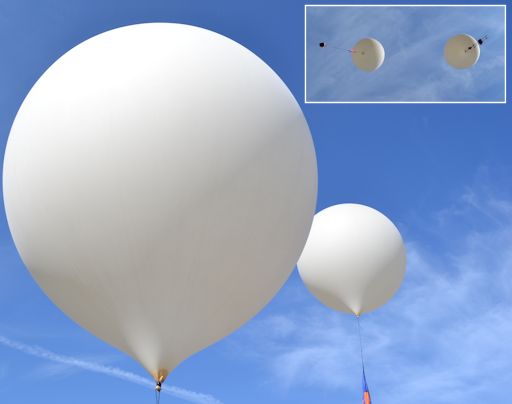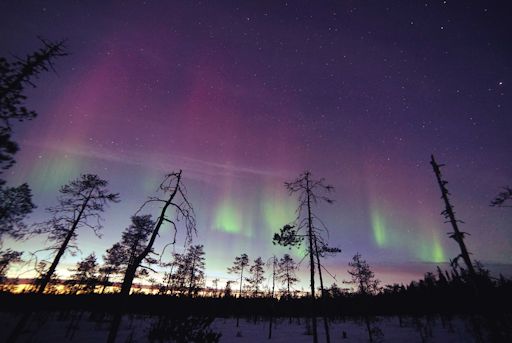Listen to radar echoes from satellites and meteors, live on listener-supported Space Weather Radio. | | |
LYRID METEOR SHOWER: Earth is approaching a stream of debris from ancient Comet Thatcher, source of the annual Lyrid Meteor Shower. Usually the shower is mild (10-20 meteors per hour) but unmapped filaments of dust in the comet's tail sometimes trigger outbursts ten times stronger. Forecasters expect this year's peak, however strong it may be, to occur on April 22nd. [meteor gallery]
SPACE WEATHER BALLOON LAUNCHED: In order to study the effects of today's geomagnetic storm on Earth's upper atmosphere, the students of Earth to Sky Calculus launched a double balloon mission to the stratosphere:

The two balloons carried two experiments. One is the group's Rapid Response Space Weather Payload, which measures high energy radiation. The other carried a colony of extreme-loving halobacteria. The purpose of their flight is to discover if they can live in the extreme environment of the stratosphere. Oh, and in honor of Easter, the students sent a team of peeponauts as well. Stay tuned for updates.
GEOMAGNETIC STORM IN PROGRESS, MORE TO COME: A minor G1-class geomagnetic storm is in progress following a CME strike during the early hours of April 20th. The impact sparked auroras over Scandinavia visible despite the brightening spring twilight. Asko Aikkila sends this picture from Kuusamo, Finland:

"Here in Finland near the Polar circle spring nights are becoming lighter and lighter, but still the a uroras are visible," says Aikkila.
This is the first of two CME impacts expected to rattle Earth's magnetic field today. NOAA forecasters expect the second CME to trigger a G2-class geomagnetic storm, which is to say "moderate." High-latitude power systems may experience voltage alarms. HF radio propagation could fade at higher latitudes, and auroras have been seen as low as New York and Idaho during such storms. Aurora alerts: text, voice
Realtime Space Weather Photo Gallery
DRAGON SIGHTING, UPDATED: Chalking up another success for commercial spaceflight, SpaceX's Dragon cargo carrier is in orbit and en route to the International Space Station. The spacecraft launched atop a Falcon 9 rocket from Cape Canaveral on Friday, April 18th, at at 3:25 p.m. EDT. Shortly after the launch, observers across Europe watched the spacecraft sail through their darkening evening sky. Astrophotographer sends this movie from Paris, France:

The brightest dot in the movie is the Dragon itself. As for the other three objects, "I don't know what they are!" says Legault. "They are probably debris such as solar panel covers or the rocket cap. I would be interested to know."
UPDATE: "The three lights associated with Dragon are the Falcon second stage and two solar panel covers," explains spaceweather.com reader Garrett Frankson. "I saw them fly over my house about an hour after the launch. Then David Dickinson (@AstroGuyz on twitter) and I went on a bit of a scavenger hunt trying to figure out what they were. There wasn't any documentation on it, but after some research and rewatching the launch footage, I spotted one of the covers tumbling away in the background. It's a pretty amazing sight to see in person, all three objects silently screeching across the sky."
Dragon will reach the ISS on Sunday, April 20th, at 7:14 am EDT. Using the space station's robotic arm, ISS Commander Koichi Wakata will take hold of the spacecraft and maneuver it to its docking port, where astronauts will begin to unload 2.5 tons of supplies and science experiments.
On its way to the ISS, SpaceX's Falcon rocket jettisoned five CubeSats. One of the satellites, PhoneSat 2.5, is the third in a series of CubeSat missions designed to use commercially available smartphone technology as part of a low-cost development effort to provide basic spacecraft capabilities. Another of the small satellites, SporeSat, is designed to help scientists study how plant cells sense gravity -- valuable research in the larger effort to grow plants in space.
Dragon is scheduled to depart the space station May 18th for a splashdown in the Pacific Ocean, west of Baja California, bringing from the space station nearly 3,500 pounds of science, hardware, crew supplies and spacewalk tools. Dragon's ability to return materials from space sets it apart from other cargo carriers that burn up upon re-entry.
Realtime Eclipse Photo Gallery
Realtime Aurora Photo Gallery
Realtime Mars Photo Gallery
Realtime Comet Photo Gallery
Every night, a network of NASA all-sky cameras scans the skies above the United States for meteoritic fireballs. Automated software maintained by NASA's Meteoroid Environment Office calculates their orbits, velocity, penetration depth in Earth's atmosphere and many other characteristics. Daily results are presented here on Spaceweather.com.
On Apr. 17, 2014, the network reported 6 fireballs.
(6 sporadics)

In this diagram of the inner solar system, all of the fireball orbits intersect at a single point--Earth. The orbits are color-coded by velocity, from slow (red) to fast (blue). [Larger image] [movies]
Potentially Hazardous Asteroids (
PHAs) are space rocks larger than approximately 100m that can come closer to Earth than 0.05 AU. None of the known PHAs is on a collision course with our planet, although astronomers are finding
new ones all the time.
On April 20, 2014 there were potentially hazardous asteroids.
Notes: LD means "Lunar Distance." 1 LD = 384,401 km, the distance between Earth and the Moon. 1 LD also equals 0.00256 AU. MAG is the visual magnitude of the asteroid on the date of closest approach. | | The official U.S. government space weather bureau |
| | The first place to look for information about sundogs, pillars, rainbows and related phenomena. |
| | Researchers call it a "Hubble for the sun." SDO is the most advanced solar observatory ever. |
| | 3D views of the sun from NASA's Solar and Terrestrial Relations Observatory |
| | Realtime and archival images of the Sun from SOHO. |
| | from the NOAA Space Environment Center |
| | the underlying science of space weather |

